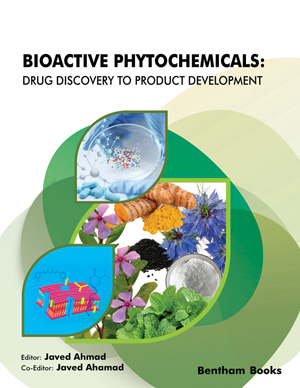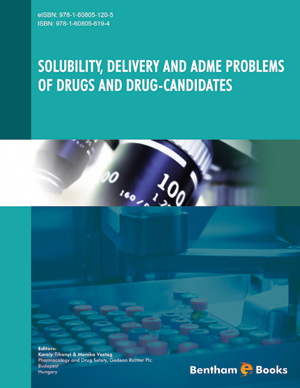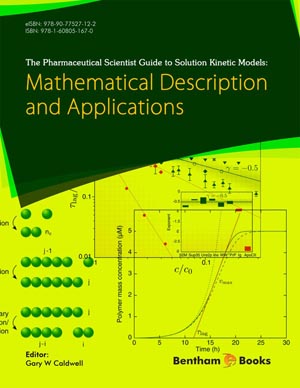Acknowledgements
Page: viii-viii (1)
Author: Eric Murillo-Rodríguez
DOI: 10.2174/9781608050284113010004
List of Contributors
Page: ix-x (2)
Author: Eric Murillo-Rodríguez
DOI: 10.2174/9781608050284113010005
Cannabinoid Receptor Gene Variations in Neuropsychiatric Disorders
Page: 3-24 (22)
Author: Hiroki Ishiguro, Claire M. Leonard, Susan Sgro and Emmanuel S. Onaivi
DOI: 10.2174/9781608050284113010006
PDF Price: $15
Abstract
The ubiquitous cannabinoid receptors (CBRs) – probably the most abundant binding sites in the CNS - are known to be involved in a number of neuropsychiatric disturbances. CBRs are coded in human chromosomes 1 and 6 and activated by endocannabinoids, phytocannabinoids and marijuana use (medical/recreational use). The components of the endocannabinoid system (ECS) include CNR1 and CNR2 genes encoding these CBRs (CB1Rs and CB2Rs), endocannabinoids (eCBs), and their synthesizing and degradation enzymes are major targets of investigation for their impact in neuropsychiatry. Hence we have continued to study the influence of CBR variants in neuropsychiatric disorders. Many studies have shown that CNR1 and FAAH single nucleotide polymorphisms (SNPs) may contribute to drug addiction, depression, eating disorders, schizophrenia, and multiple sclerosis. But little attention has been paid to the neuronal and functional expression of CB2Rs in the brain and their role in neuropsychiatric disorders has been much less well characterized. Indeed our studies provided the first evidence for neuronal CNS effects of CB2Rs and their possible role in drug addiction, eating disorders, psychosis, depression and autism spectrum disorders (ASDs). In the current ongoing studies many features of CBR gene structures, SNPs, copy number variations (CNVs), CpG islands, microRNA regulation and the impact of CBR gene variants in neuropsychiatry and where possible in rodent models have been assessed. Although CNR1 gene has more CpG islands than CNR2 gene, both have CPG islands less than 300 bases, but they may be regulated by DNA methylation. MicroRNA binding to the 3′ untranslated region of the CNR1 gene with two polyadenylation sites may also potentially regulate CB1R expression. CNR1 gene has 4 exons and there are 135 SNPs reported in more than 1% of the population with no common SNP that changes amino acids of CB1R currently known or reported. A copy number variant (CNV) which is 19.5kb found in 4 out of 2026 people covers exons 3 and 4 and codes amino acid that could alter the expression of CB1Rs. CNR2 has 4 exons with CB2A with 3 exons and CB2B with 2 exons; and there are about 100 SNPs found in more than 1% of the population, which include common cSNPs that change amino acids of the CB2R, including R63Q, Q66R and H316Y. CNVs in Asian and Yoruba population have been reported. We also report on the identification of novel human and rodent CB2R isoforms, their differential tissue expression patterns and regulation by CBR ligands. Our findings also indicate increased risk of schizophrenia, depression, drug abuse, and eating and autism spectrum disorders in low CB2R function. Therefore, studying the CBR genomic structure, its polymorphic nature, subtype specificity, its variants and associated regulatory elements that confer vulnerabilities to a number of neuropsychiatric disturbances may provide deeper insight in unraveling the underlining mechanisms. Thus, understanding CBR variants and other components of the ECS may provide novel targets for the effects of cannabinoids in neuropsychiatry. Support R15DA032890 and WPUNJ.
The Role of Endocannabinoids and Arachidonic Acid Metabolites in Emesis
Page: 25-59 (35)
Author: Nissar A. Darmani and Seetha Chebolu
DOI: 10.2174/9781608050284113010007
PDF Price: $15
Abstract
Research in the last decade has well established that Δ9-THC and related synthetic direct-acting cannabinoid CB1/2 receptor agonists (such as WIN55,212-2, CP55,940) possess broad-spectrum antiemetic efficacy against diverse emetogens via activation of CB1 receptors. We now extend the antiemetic efficacy of these CB1/2 agonists against 20-hydroxyPGE2 and arachidonoyl-2-chloroethylamide (ACEA). Increasing evidence in more recent years also suggests that chronic use of large doses of Δ9-THC in humans can induce intractable vomiting referred to as the cannabinoid hyperemesis syndrome. This chapter discusses the antiemetic/proemetic potential of endocannabinoids such as anandamide, virodhamine, NADA and 2-AG as well as that of synthetic indirectacting cannabimimetic agents that increase endogenous endocannabinoid tissue levels either by inhibiting their metabolism {such as FAAH and MAGL inhibitors (e.g. AA-5- HT/URB597 and JZL184, respectively)} or by blocking their reuptake (e.g. OMDM1, VDM11, AM404). To date published findings indicate that exogenous administration of either 2-AG or anandamide can lead to both antiemetic and proemetic effects depending upon the laboratory conditions used and/or the emetic models utilized. Furthermore, lack of full dose-response studies in most emesis models further confounds a firm conclusion. Likewise, available data indicate that the well-studied FAAH inhibitor URB597 and the above reuptake blockers can prevent vomiting induced by some but not all tested emetogens, and at large doses they can be emetic by themselves. It appears that while the antiemetic efficacy of exogenously-administered endocannabinoids (as well as that of drugs that increase their endogenous levels) is due to activation of CB1- or CB1/TRPV1- receptors, e.g. 2-AG or anandamide, respectively, their emetic potential reside in their tendency to be rapidly metabolized to the proemetic agent arachidonic acid and its downstream emetic metabolites such as prostaglandins (e.g. PGE2, 20-hydroxyPGE2 and PGF2α), leukotrienes (e.g. LTC4 and LTD4) and/or 20-HETE. In fact some analogs of anandamide such as ACEA (a selective CB1 agonist) that are more rapidly metabolized are proemetic, while its more stable congeners (methanandamide or ACPA) lack emetic activity. Thus, exogenously-administered endocannabinoids and drugs that enhance their tissue levels can be antiemetic under certain conditions but unlike Δ9-THC they generally lack broad-spectrum antiemetic efficacy.
On the Cannabinoid Regulation of Energy Homeostasis: Past, Present and Future
Page: 60-91 (32)
Author: Amanda Borgquist and Edward J. Wagner
DOI: 10.2174/9781608050284113010008
PDF Price: $15
Abstract
The term “cannabinoid” refers to the class of 60 or so compounds found in the plant Cannabis sativa, of which Δ9-tetrahydrocannabinol (THC) is the major bioactive constituent. In addition, endogenous cannabinoids such as anandamide and 2-arachidonyl glycerol are synthesized de novo from phospholipids via the enzymatic activities of phospholipases such as phospholipase (PL)C, PLD and diacylglycerol lipase. These compounds act to varying degrees at three subtypes of cannabinoid receptors: the CB1 and CB2 receptors, as well as GPR55. There is a wealth of evidence demonstrating that both endogenous and exogenous cannabinoids regulate energy homeostasis by increasing energy intake and decreasing energy expenditure. Based on our current understanding it is apparent that this occurs via complex interactions between the gut, liver, pancreas, brainstem, hypothalamus and limbic forebrain. Moreover, the regulatory effects of cannabinoids on energy balance are sexually differentiated and subject to the modulatory influences of steroid and peptide hormones. This chapter endeavors to explore the continuum of developments in the intensive, 40+-year study of how cannabinoids regulate food intake, gastrointestinal motility and secretion, fat and carbohydrate disposition, mitochondrial respiration and core body temperature. It is anticipated that this work will offer new insight and provide a newfound appreciation of the pleiotropic mechanisms through which cannabinoids control energy homeostasis.
Structural Biology of Endocannabinoid Targets and Enzymes: Components Tuned to the Flexibility of Endogenous Ligands
Page: 92-131 (40)
Author: Dow P. Hurst, Jagjeet Singh and Patricia H. Reggio
DOI: 10.2174/9781608050284113010009
PDF Price: $15
Abstract
The lipid bilayer plays a major role in the “life-cycle” of the endocannabinoids, anandamide and 2-AG. These ligands are synthesized on demand in the lipid bilayer; act at membrane embedded cannabinoid receptors that may be accessed via the lipid bilayer; and, are degraded by membrane associated enzymes that have lipid entry portals for their respective endocannabinoids (2-AG-Monoacylglycerol lipase (MGL); AEA-Fatty acid amide hydrolase (FAAH)). Transport for degradation (especially for AEA) remains a hot research topic, as AEA must leave the plasma membrane and travel inside the cell to FAAH which is associated with the membrane of the endoplasmic reticulum. This review focuses on structural features of each of the components of the endocannabinoid signaling system, including the enodogenous ligands themselves. For the homo-allylic double bond pattern in their arachidonyl acyl chains confers the “dynamic plasticity” that these ligands require to navigate the bilayer, thread through entry portals of the receptors, and enter lipid entry portals of the enzymes that comprise the endocannabinoid signaling system.
Dynamic Interactions Between Drugs of Abuse and the Endocannabinoid System: Molecular Mechanisms and Functional Outcome
Page: 132-163 (32)
Author: Miriam Melis, Anna L. Muntoni and Marco Pistis
DOI: 10.2174/9781608050284113010010
PDF Price: $15
Abstract
Regulation of motivated behavior toward both natural stimuli and drugs of abuse is among functions where the endocannabinoid system is deeply engaged. In fact, endocannabinoids and their receptors (CB1) are abundant in the limbic system and, particularly, they serve as retrograde signaling molecules at synapses onto midbrain dopamine (DA) neurons in the ventral tegmental area (VTA). These neurons are involved in neural processing contributing to drug addiction and DA plays a crucial role as learning signal, by changing the synaptic strength of neural circuits involved in action selection to optimize goal-directed behavior.
Endocannabinoids regulate different forms of synaptic plasticity in the VTA, exert a critical modulation of DA release and, ultimately, of the circuits within the limbic systems driving motivated behaviors. Hence, it is not surprising that drugs of abuse, namely alcohol, nicotine, opioids and psychostimulants exert wide arrays of effects on the endocannabinoid system, by affecting endocannabinoid release and catabolism as well as modulation of the functions and number of cannabinoid CB1 receptors. On the other hand, by genetic or pharmacological manipulation of the endocannabinoid system we can modulate neurochemical and neurophysiological effects of the drugs as well as their behavioral actions in experimental animals predictive of their addicting properties in humans. Accordingly, blockade of CB1 receptors was a promising therapeutic strategy against drug addiction, although rimonabant (the only clinically tested CB1 antagonist) was withdrawn due to serious side effects such as depression and suicide. These adverse effects though underscore the general role that the endocannabinoid system plays in the regulation of reward and motivation. Nevertheless, other drugs are emerging, i.e. the indirect cannabinoid agonists, which enhance endocannabinoids by blocking their catabolism or membrane transport, that are efficacious in animal model of relapse to drug addiction and that might prove beneficial in humans.
The Development of Cannabinoid Based Therapies for Epilepsy
Page: 164-204 (41)
Author: Andrew J. Hill, Thomas D.M. Hill and Benjamin J. Whalley
DOI: 10.2174/9781608050284113010011
PDF Price: $15
Abstract
Epilepsy is a chronic, progressive, neurological disorder affecting ~0.5-1% of the population for which there is no cure. Furthermore, efficacious seizure suppression is yet to be achieved for all patients; ~35% of people with epilepsy (PWE) have seizures pharmacoresistant to existing drugs. In this regard, the endocannabinoid system (ECS) is an attractive therapeutic target as it can limit synaptic transmission to oppose hyperexcitability in addition to central cannabinoid type-2 receptor (CB2R) modulation potentially limiting neuronal death associated with epilepsy. Postsynaptic endocannabinoid (eCB) synthesis is stimulated by excitatory neurotransmission, eCBs then act retrogradely via presynaptic cannabinoid type-1 receptors (CB1R) to suppress subsequent excitatory (glutamatergic) and inhibitory (GABAergic) synaptic activity close to the synthetic locus. Thus, eCBs can limit excessive excitation but also hinder inhibitory processes such that their effects on epileptic foci and the spread of seizure activity is dependent on the relative proportions of excitatory and inhibitory synapses, and their organisation into local and global circuits within the CNS. Cannabis has a history of antiepileptic use that continues to the present day in medical marijuana programmes, and CB1R receptor agonism, either by medical marijuana, pure Δ9-tetrahydrocannabinol (Δ9-THC) or synthetic CB1R ligands, can be anticonvulsant in humans and in in vitro and in vivo seizure models, but paradoxically can cause seizures in healthy rodents. Furthermore, it is clear that other cannabis constituents are anti-epileptic, and, whilst the mechanisms by which they act remain undetermined, they certainly extend beyond ECS modulation. Moreover, whilst CB1R agonism can control seizures in some patients and many animal seizure models, it is unlikely to represent a widely exploitable target for seizure control due to its psychoactive sequelae. Conversely, many non-Δ9-THC plant cannabinoids are inactive at CB1R or CB2R at therapeutically relevant concentrations and a subset of these (e.g. cannabidiol) exert significant anticonvulsant effects in numerous animal models of seizure at clinically promising doses.
Index
Page: 205-208 (4)
Author: Eric Murillo-Rodríguez, Emmanuel S. Onaivi, Nissar A. Darmani and Edward Wagner
DOI: 10.2174/9781608050284113010012
Introduction
The endocannabinoid system comprises at least two G-protein-coupled receptors (the cannabinoid CB1 and CB2 receptors) activated by marijuana’s psychoactive principle ∆9-tetrahydrocannabinol (THC) and the endogenous ligands known as endocannabinoids. The apex of endocannabinoid research seems to have been reached with the clinical development, and also in some cases, the marketing, of synthetic or natural pharmaceuticals targeting this signalling system, which followed the understanding of the physiological and pathological role of endocannabinoids in several conditions, a role that was investigated first in rodent experimental models and then in humans. Endocannabinoids: Molecular, Pharmacological, Behavioral and Clinical Features is a monograph that presents interesting manuscripts selected by the editor on the subject. Chapters in this book include original research or reviews which report the relevance of the endocannabinoid system by describing the results of experimental evidence about the neurobiological role of the endocannabinoid system. The main topics include, but are not limited to: *The genetics of cannabinoid CB1 and CB2 receptors and their tissue distribution, their splicing variants and polymorphisms, and the possible implications of all this in determining different behaviours as well as various pathological conditions and the addiction to substances of abuse. *Pharmacological approaches describing the potential use in the central nervous system disorders of endocannabinoid-based drugs, such as cannabinoid receptor agonists and antagonists, inhibitors of endocannabinoid inactivation processes, and even plant cannabinoids other than THC and with a molecular mechanism of action. *The role of the endocannabinoid system in several neurological and neuropsychiatric conditions, such as epilepsy. The volume would be a great interest to neuropharmacologists, physiologists and biochemists who aim to learn about the endocannabinoid system in detail.






















